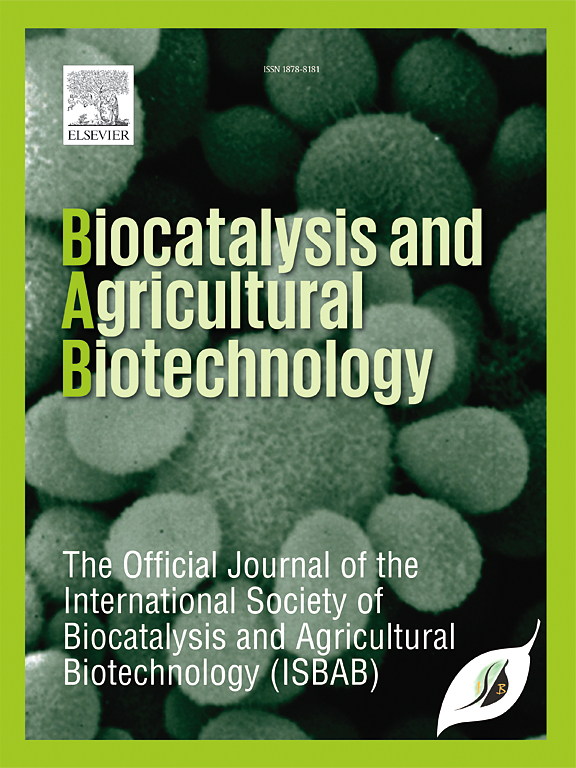Camel urine-priming induced defense mechanisms in barley against Fusarium graminearum
IF 3.8
Q2 BIOTECHNOLOGY & APPLIED MICROBIOLOGY
引用次数: 0
Abstract
Fusarium graminearum poses a major threat to barley production worldwide. While seed priming is a promising strategy to enhance plant defense, the use of unconventional priming agents remains underexplored. This study investigates the protective effects of pre-infection camel urine seed priming on barley seedlings challenged with Fusarium graminearum, focusing on growth, disease resistance, oxidative stress, and defense-related responses. Barley grains were primed with camel urine and grown in both Fusarium-infested and uninfested soils. Fusarium infection initially triggered a sharp increase in oxidative stress markers reflecting an early oxidative burst commonly associated with defense signaling. However, in hydro-primed seedlings, this response persisted, leading to sustained oxidative damage and growth suppression. In contrast, camel urine priming modulated the oxidative burst effectively, initially permitting H2O2 accumulation for defense activation, followed by a rapid decline, resulting in an 84.53 % reduction in disease severity and maintenance of seedling growth under infection. This was accompanied by enhanced antioxidant defenses, as indicated by significantly increased activities of antioxidant enzymes, and a 145 % increase in total antioxidant capacity compared to control. Camel urine priming also showed a reduction in shikimic acid levels under infection, suggesting increased metabolic flux toward the phenylpropanoid pathway. Thus, phenylalanine ammonia-lyase activity, phenolic compounds, and flavonoids were significantly elevated. Antifungal enzymes, β-glucanase and chitinase, also remained high in camel urine-primed seedlings, in contrast to their sharp decline in hydro-primed controls. These findings highlight camel urine priming as a promising, sustainable approach for managing Fusarium in barley.
骆驼尿诱导大麦对小麦镰刀菌的防御机制
小麦镰刀菌对全球大麦生产构成重大威胁。虽然种子引种是一种很有前途的增强植物防御的策略,但非常规引种剂的使用仍未得到充分探索。本研究研究了感染前骆驼尿种子启动对大麦镰刀菌侵染的保护作用,重点研究了生长、抗病、氧化应激和防御相关反应。用骆驼尿浸泡大麦籽粒,在镰刀菌侵染和未侵染的土壤中生长。镰刀菌感染最初引发氧化应激标志物的急剧增加,反映了通常与防御信号相关的早期氧化爆发。然而,在水激发的幼苗中,这种反应持续存在,导致持续的氧化损伤和生长抑制。相比之下,骆驼尿启动有效地调节了氧化爆发,最初允许H2O2积累用于防御激活,随后迅速下降,导致疾病严重程度降低84.53%,并维持了感染下的幼苗生长。与对照组相比,抗氧化酶活性显著增加,总抗氧化能力增加了145%,这表明抗氧化防御能力增强。骆驼尿启动也显示感染后莽草酸水平降低,表明向苯丙素途径的代谢通量增加。因此,苯丙氨酸解氨酶活性、酚类化合物和黄酮类化合物显著升高。抗真菌酶,β-葡聚糖酶和几丁质酶,在骆驼尿启动的幼苗中也保持高水平,而在水启动的对照中则急剧下降。这些发现强调了骆驼尿作为一种有前途的、可持续的大麦镰刀菌管理方法。
本文章由计算机程序翻译,如有差异,请以英文原文为准。
求助全文
约1分钟内获得全文
求助全文
来源期刊

Biocatalysis and agricultural biotechnology
Agricultural and Biological Sciences-Agronomy and Crop Science
CiteScore
7.70
自引率
2.50%
发文量
308
审稿时长
48 days
期刊介绍:
Biocatalysis and Agricultural Biotechnology is the official journal of the International Society of Biocatalysis and Agricultural Biotechnology (ISBAB). The journal publishes high quality articles especially in the science and technology of biocatalysis, bioprocesses, agricultural biotechnology, biomedical biotechnology, and, if appropriate, from other related areas of biotechnology. The journal will publish peer-reviewed basic and applied research papers, authoritative reviews, and feature articles. The scope of the journal encompasses the research, industrial, and commercial aspects of biotechnology, including the areas of: biocatalysis; bioprocesses; food and agriculture; genetic engineering; molecular biology; healthcare and pharmaceuticals; biofuels; genomics; nanotechnology; environment and biodiversity; and bioremediation.
 求助内容:
求助内容: 应助结果提醒方式:
应助结果提醒方式:


